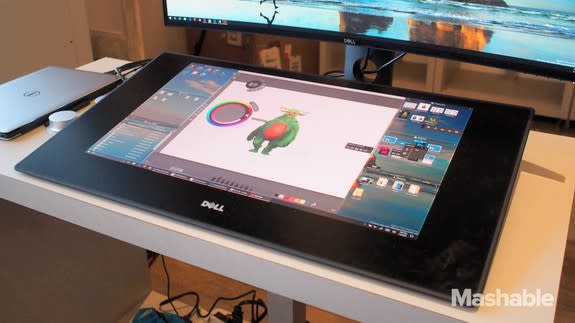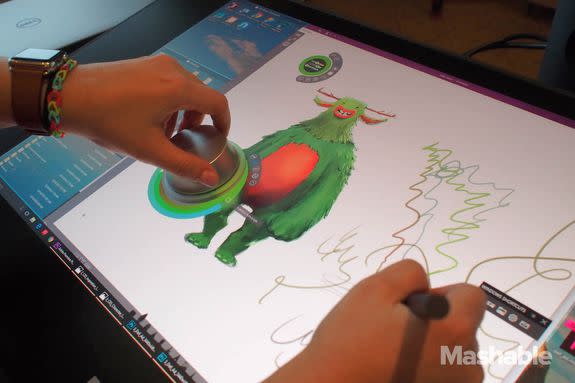Dell Canvas gives you Surface Studio abilities without the luxury price tag

LAS VEGAS — The first thing you'll think when you see the Dell Canvas is, "This looks a lot like the Microsoft Surface Studio." But they're actually very different products.
You'd be forgiven for making the connection, though, since the Canvas appears to have many of the features that make the Surface Studio stand out. Both have big, flat screens that sit at an angle most of the time — making them both resemble a drafting board. Both are aimed first and foremost at creative types, with support for a stylus. And most glaringly, both have a dial-like accessory that can quickly adjust settings, even while you're doing something in the other hand, like changing the color of your pen stroke while you draw.
SEE ALSO: Is Apple neglecting the Mac?
But the similarities stop there. For starters, the Canvas, which costs $1,799, is simply a large and highly specialized touch display — it connects to a PC (via Thunderbolt or USB), but doesn't replace it. At a demo at CES 2017, a Dell laptop was connected to the Canvas, driving it as well as a large curved monitor. But a user could use it in any number of configurations: just the Canvas, the Canvas and the laptop screen, or something else.
As a display, the Canvas' specs are respectable, if not great. The 27-inch screen has a resolution of 2,560 x 1,440 or Quad HD. It's protected by Corning Gorilla Glass, so it can take some punishment, and it's etched with an anti-reflective coating, which gives it more of a matte texture compared to your average smartphone.
The Dell Canvas in action. #MashCES #CES2017
A video posted by Pete Pachal (@mirrorpete) on Jan 5, 2017 at 7:56pm PST
One of the things that strikes you right away about the Canvas is the relatively thick bezel — there's a 4-inch gap between the edge of the display and the side of the device (1 inch on the top and 3 inches on the bottom). Dell reps said it built the Canvas that way because of user feedback: artists in particular wanted a large bezel so they wouldn't have to worry about grand, sweeping pen strokes.
Dell built the device with the upcoming Windows 10 Creators Update in mind. The screen can support 20 points of touch (instead of the usual 10), and the digital pen has 2,048 points of pressure (the Surface Pen only does 1,024). And unlike the Surface Studio, the dial accessory is included in the box. In fact, it comes with two: a large one (the Dial) and a small one (the Knob).

Image: Pete Pachal/Mashable
Let's talk about those dials (which Dell calls "totems"). Only the large one was available at the demo, but it looked and worked almost exactly like the Surface Dial. Once you hold it, though, you realize it's worlds apart: Dell's dial feels like a cheap plastic version of the genuine article. It's noticeably lighter, doesn't feel like real metal, and it doesn't have anywhere near the same precision.
It's poorly designed, too: If you're not holding the Dial up against the screen, it has a tendency to slide off if the Canvas is raised at an angle. The Surface Dial, by contrast, has a rubberized bottom that's sticky enough to stay on the Studio even at raised angles.

Image: Pete Pachal/Mashable
Speaking of angles, the Canvas can rise to a maximum of 11 degrees. However, Dell says it will sell an optional $399 stand that can raise that angle to up to 85 degrees in case you want to treat it more like a regular monitor. You can also wall-mount it.
As I used the Canvas, I definitely felt echoes of the Surface Studio — right down to the features on display. In the app Sketchables, you can use the dial to change the color of your pen stroke as you draw. Dell also has some workspace organization tools that dovetail nicely with the Canvas, such as organizing multiple workspaces on a single desktop, but that's not specific to the device.

Image: Pete Pachal/Mashable
Overall, I can see the Canvas appealing to pros and creatives on Windows (it doesn't work with Macs, natch) who don't want to shell out $3,000+ for the Studio or simply don't want to marry themselves to an all-in-one PC. There are plenty of artists who use a Wacom Pen Display with a laptop or other kind of computer so they can simply disconnect when they want to do other stuff. The Canvas has that flexibility, too.
If all this sounds appealing to you — and you don't plan to use Dell's lousy Dial — the Canvas could be a great fit for your workflow. In any case, between the Surface Studio, Apple's new MacBook with Touch Bar and new form factors like the Dell Canvas, 2017 is looking to be a golden age in digital tools for the creative set.
